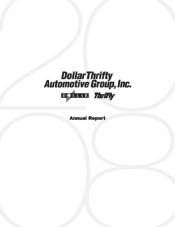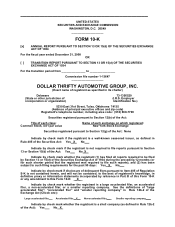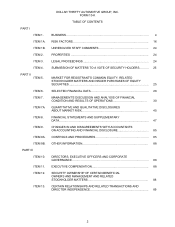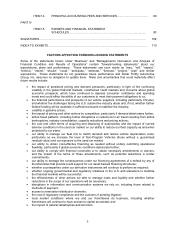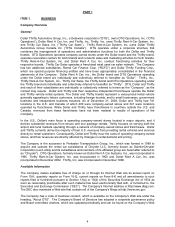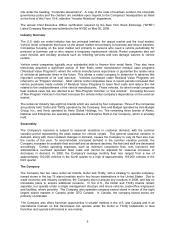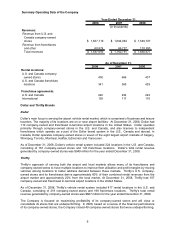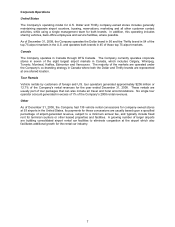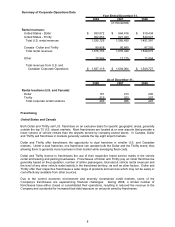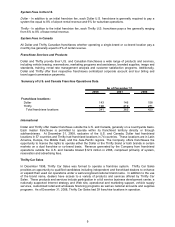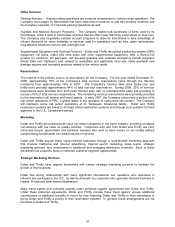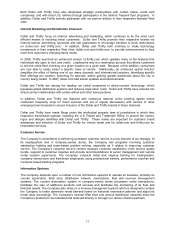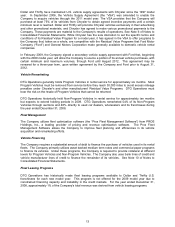Thrifty Car Rental 2008 Annual Report Download - page 5
Download and view the complete annual report
Please find page 5 of the 2008 Thrifty Car Rental annual report below. You can navigate through the pages in the report by either clicking on the pages listed below, or by using the keyword search tool below to find specific information within the annual report. ITEM 14. PRINCIPAL ACCOUNTING FEES AND SERVICES….…………………......... 89
PART IV
ITEM 15. EXHIBITS AND FINANCIAL STATEMENT
SCHEDULES………….………………………………………………….............
90
SIGNATURES……………………………………………………………….………………………………... 109
INDEX TO EXHIBITS………………………………………………………………………...………………… 110
FACTORS AFFECTING FORWARD-LOOKING STATEMENTS
Some of the statements herein under “Business” and “Management’s Discussion and Analysis of
Financial Condition and Results of Operations” contain “forward-looking statements” about our
expectations, plans and performance. These statements use such words as “may,” “will,” “expect,”
“believe,” “intend,” “should,” “could,” “anticipate,” “estimate,” “forecast,” “project,” “plan” and similar
expressions. These statements do not guarantee future performance and Dollar Thrifty Automotive
Group, Inc. assumes no obligation to update them. Risks and uncertainties that could materially affect
future results include:
• the impact of persistent pricing and demand pressures, particularly in light of the continuing
volatility in the global financial markets, constrained credit markets and concerns about global
economic prospects, which have continued to depress consumer confidence and spending
levels and could affect the ability of our customers to meet their payment obligations to us;
• the financial performance and prospects of our vehicle suppliers, including particularly Chrysler,
and whether the challenges facing the U.S. automotive industry abate and, if not, whether further
federal funding will be available in sufficient amounts to stabilize the industry;
• volatility in gasoline prices;
• the impact of pricing and other actions by competitors, particularly if demand deteriorates further;
• airline travel patterns, including further disruptions or reductions in air travel resulting from airline
bankruptcies, industry consolidation, capacity reductions and pricing actions;
• the cost and other terms of acquiring and disposing of automobiles and the impact of current
adverse conditions in the used car market on our ability to reduce our fleet capacity as and when
projected by our plans;
• our ability to manage our fleet mix to match demand and reduce vehicle depreciation costs,
particularly as we increase the level of Non-Program Vehicles (those without a guaranteed
residual value) and our exposure to the used car market;
• our ability to obtain cost-effective financing as needed without unduly restricting operational
flexibility, particularly if global economic conditions deteriorate further;
• our ability to comply with financial covenants or to obtain necessary amendments or waivers,
and the impact of the terms of those amendments, such as potential reductions in lender
commitments;
• our ability to manage the consequences under our financing agreements of a default by any of
the Monolines that provide credit support for our asset backed financing structures;
• whether counterparties under our derivative instruments will continue to perform as required;
• whether ongoing governmental and regulatory initiatives in the U.S. and elsewhere to stabilize
the financial markets will be successful;
• the effectiveness of other actions we take to manage costs and liquidity and whether further
reductions in the scope of our operations will be necessary;
• disruptions in information and communication systems we rely on, including those related to
methods of payment;
• access to reservation distribution channels;
• the cost of regulatory compliance and the outcome of pending litigation;
• local market conditions where we and our franchisees do business, including whether
franchisees will continue to have access to capital as needed; and
• the impact of natural catastrophes and terrorism.
3

